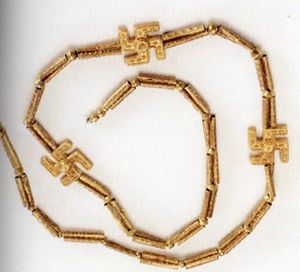Aryan facts for kids
Aryan is a name that ancient people in parts of Europe, Iran, and India used for themselves. These people lived about 3,500 years ago. They used the name Aryan to mean their shared ancestors or "noble" people.
Many languages today, like Sanskrit in India and Avestan in Iran, come from the languages spoken by these ancient Aryans. These languages are part of a bigger group called Indo-European languages. The name Iran itself comes from the Persian word for Aryan.
Contents
Aryan Ideas and Nazism
In the late 1800s, some people in Europe started using the name Aryan in a different way. They began to say it only referred to certain European people, especially those from northern Europe, like the Nordic people. They wrongly claimed these groups were a "pure," "noble," and "superior" race.
This idea became very popular in Germany. People believed that these "Aryans" were the same as ancient Germanic groups like the Goths. These ideas were often mixed with anti-Jewish beliefs.
The Master Race Theory
The idea of a "Master Race" became a main part of Nazism. The Nazis were a political group that took power in Germany in 1933. Their beliefs led to terrible treatment of Jewish people. This persecution ended in the Holocaust, where millions of Jews were killed.
Modern View of Aryans
Today, scientists completely reject the racist ideas that the Nazis had about "Aryans." Most scientists agree that the original Aryans (also called Indo-Iranians) lived about 5,000 years ago. They believe these people lived in an area east of Ukraine and north of the Caucasus Mountains.
From there, some groups migrated east to Iran and India. Other groups, who became the ancestors of modern European peoples, migrated west. This idea is known as the Kurgan hypothesis.
Related pages
Images for kids
-
This map shows the approximate area of Āryāvarta during the late Vedic period (around 1100-500 BCE). Aryavarta was in northwest India and the western Ganges plain.
-
This is a title card from the old silent movie The Birth of a Nation (1915). It uses "Aryan birthright" to mean "white birthright."
See also
 In Spanish: Arios para niños
In Spanish: Arios para niños







